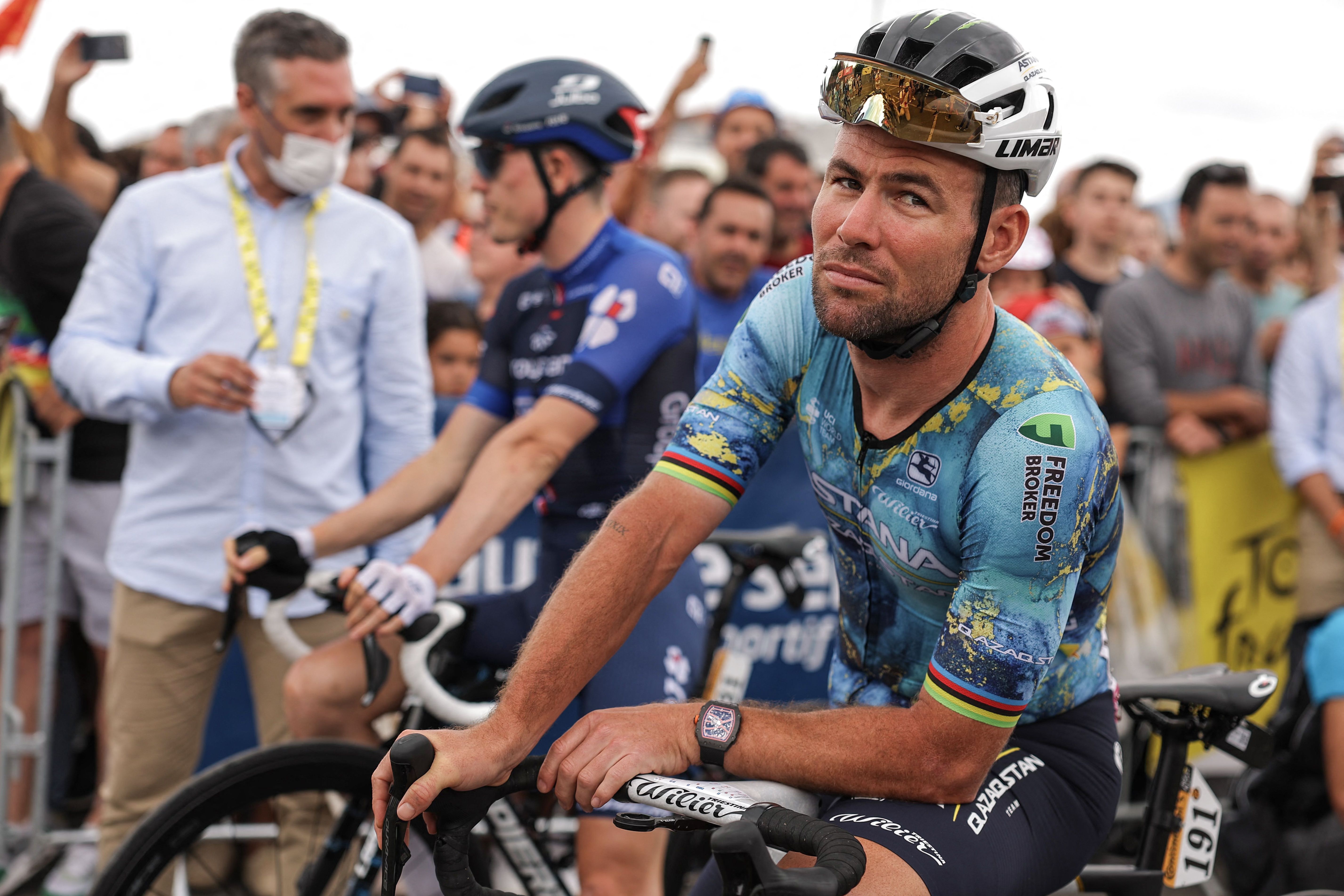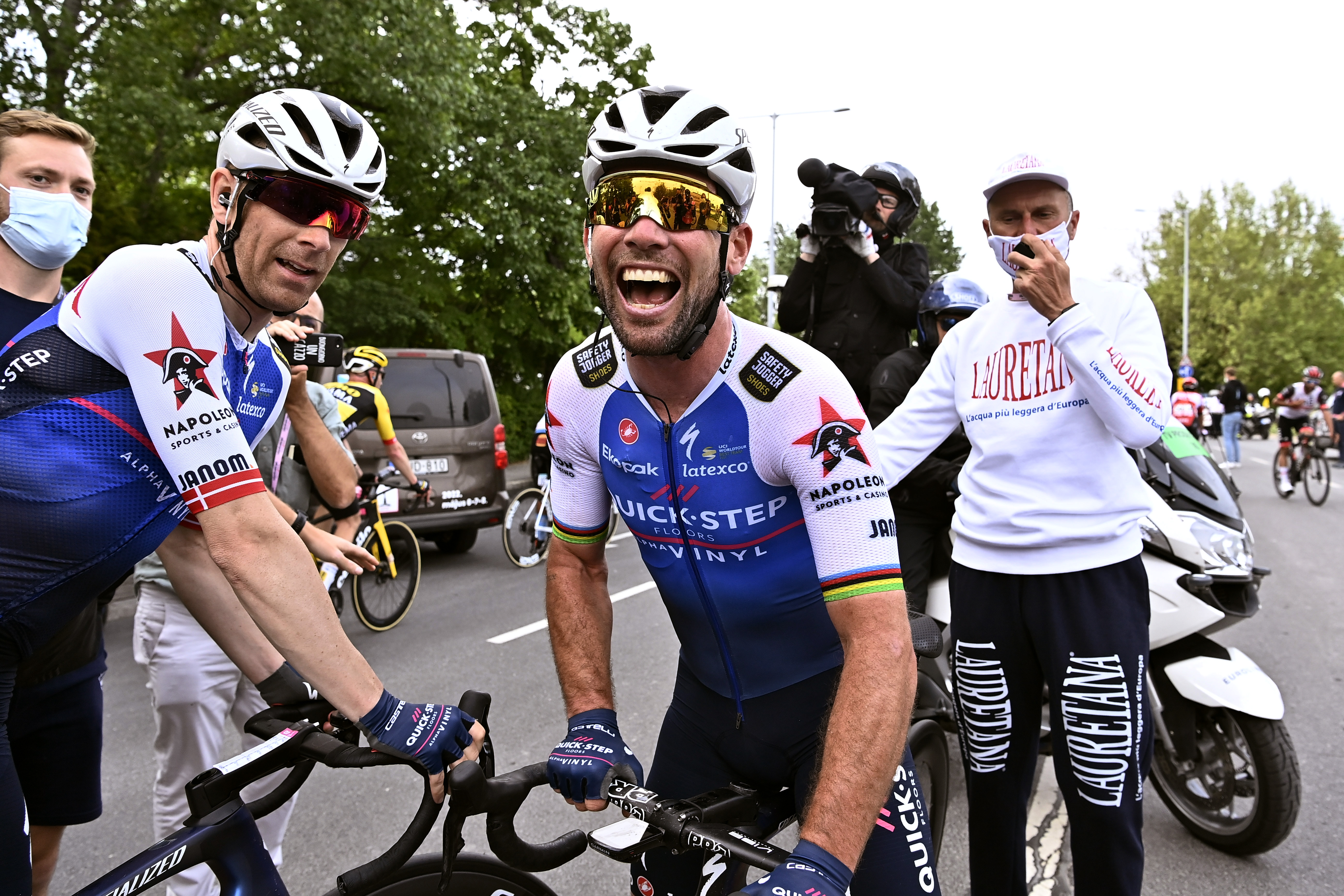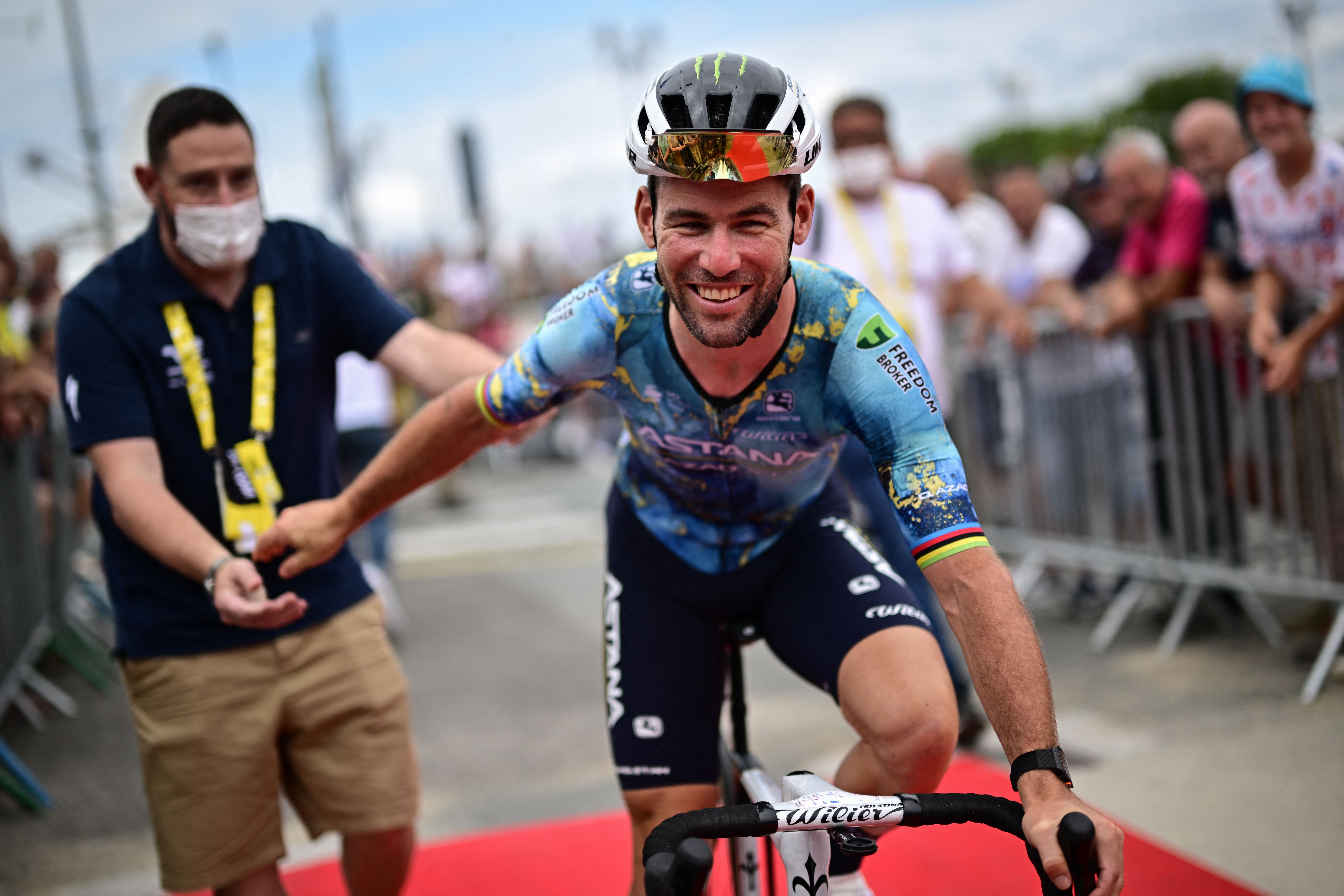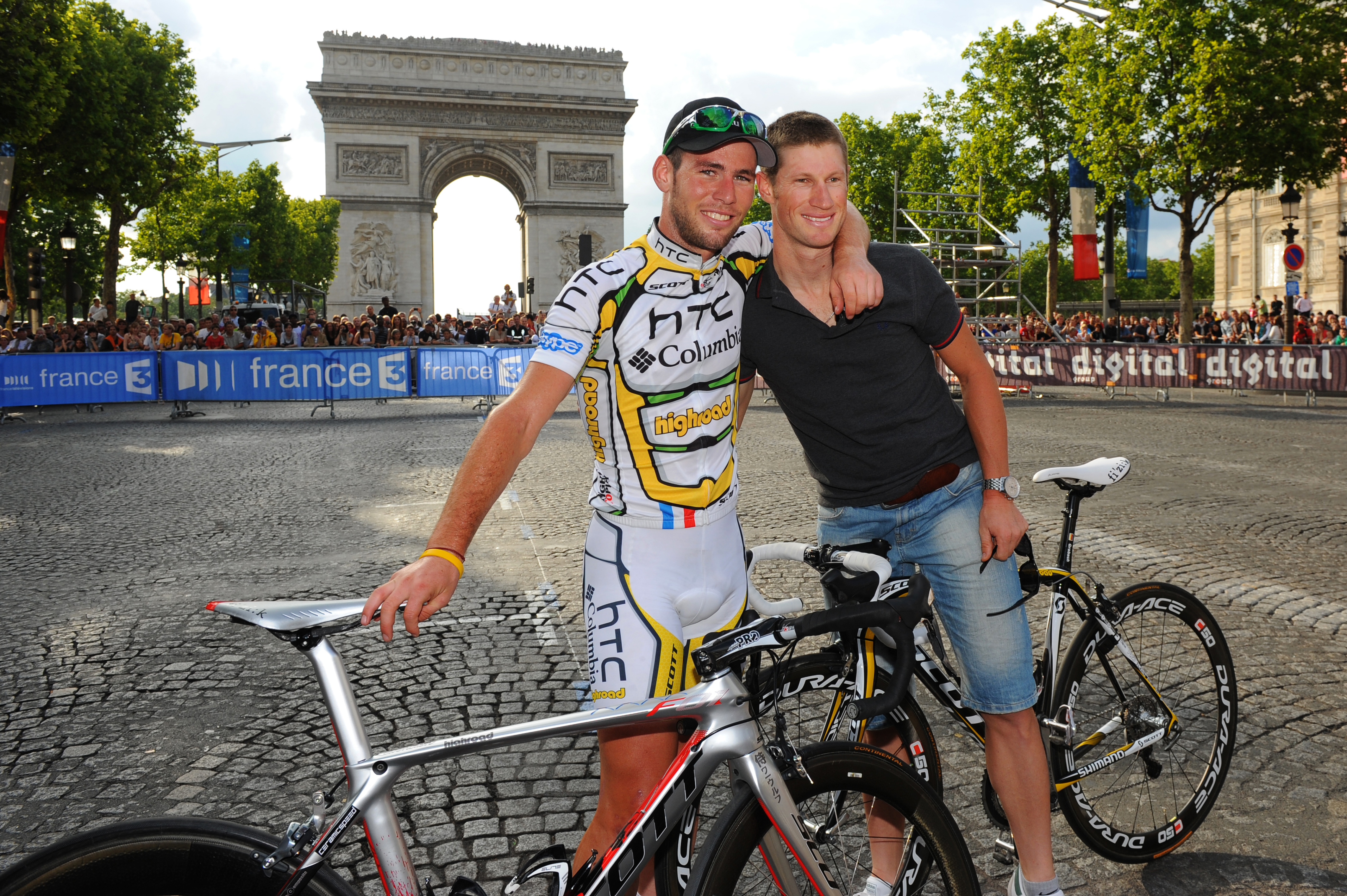

For Michael Mørkøv, the call to form part of Mark Cavendish’s repeat bid for a record-breaking 35th Tour de France stage win in 2024 could hardly have been more memorable. It can’t be that often, after all, that a sprinter of Cavendish’s calibre tells a lead-out man that his career shelf-life hangs on his decision.
“When Mark rang me, he told me that if I joined Astana, he would extend his contract,” Mørkøv says at the Astana Qazaqstan training camp, breaking into a smile as he recounts Cavendish's persistence.
“He put a bit of pressure on me. I wouldn’t want to be the one stopping him from continuing. But I’m also quite sure he would have continued without me. It was just his way of playing his cards.
“But I did have the feeling that he wanted me to join this team, because we had a very good history in the past, let’s say. And for me, it was a great opportunity because he was one of the sprinters I had the greatest success with, and that comes about from the trust he has in me. He trusts me 100%, which allows me to be the best version of myself.”
The call from Cavendish came, Mørkøv reveals, just a day after the Manxman broke his collarbone and abandoned this year’s Tour, still one stage short of breaking the record he has shared with Eddy Merckx since 2021.
“I saw his name on the phone call and before I picked it up, I knew why he was calling. I told him that I knew why and he was like, ‘Yeah, you know…’ He was sitting in hospital, making a list of what he needed for next year,” Mørkøv says.
“He was super motivated and that also motivated me. So I’m not doing this because it’s him, but because we worked so well together in the past. As a lead-out man, that’s so important.”
And so Mørkøv was in from the get-go in what is certain to be one of the most talked-about projects of the new year in professional cycling. Needless to say, Cavendish’s aim in 2024 is to bounce back to win that weighty 35th Tour stage win, in part courtesy of a major overhaul of Astana Qazaqstan.
The Kazakhstani squad are one of the longest-surviving modern-day pro teams, but until Cavendish arrived, they had never had any major sprinters on their books. And in 2024, they will be taking that new focus to what Cavendish hopes will be a whole new level.

A year ago, Cavendish was a late, late signing for Astana after the collapse of the B&B Hotels project, and manager Alexandre Vinokourov also moved to bring in Dutch sprinter Cees Bol as a lead-out man. Midway through the season, Astana added Mark Renshaw, Cavendish’s former lead-out man who retired a few years back, to look after their sprinting project, and they began discussions to bring in Vasilis Anastopoulos, Cavendish’s old trainer at Soudal-QuickStep.
However, the lateness of Cavendish’s arrival meant that they were trying to assemble a sprint unit on the hoof. A lot more needed to be done and there simply wasn’t the time. Still, every cloud has a silver lining. Cavendish’s crash and subsequent decision to delay his retirement by another year has permitted an even more fundamental and widespread repositioning of targets, strategies and resources.
“When they signed Mark last year, I realised Astana did a lot in a very short space of time, coming from never being a sprint team before to supporting him,” Mørkøv says.
“Then when he agreed to continue this summer, they had a lot more time, buying in a lot more riders who can support him and support us. And from a material point of view, they’re really pushing the limits to get the new sponsors for us.”
The increase in sprinting firepower has been remarkable. Of the 14 new signings, arguably the two key additions to the Cavendish lead-out are Davide Ballerini and Michael Mørkøv, both part of the QuickStep train that took Cavendish to such spectacular Tour de France success in 2021.
Astana have also added German speedsters Max Kanter and Rüdiger Selig to their roster, and they have promoted Italian Michele Garzoli, an allrounder with a fast finish, from their development team to the senior squad.
Nor should another Astana sprinter already in the squad, Gleb Syritsa, be overlooked. Now 23, he captured a couple of stages at the Tour of Langkawi last year and, given his age, presumably has ample margin for improvement. So, it’s fair to say that even when Cavendish does finally retire, Astana aim to benefit from his legacy and their radical change of priorities for quite some time to come.
“I feel really lucky to be on a team like this, because for so many squads now GC is a big priority"
Michael Mørkøv
However, given his role in guiding Cavendish to so many victories during his time at QuickStep, including the four on the 2021 Tour, Michael Mørkøv is surely the most indispensable new figure of all, at least in the here and now. But for the Dane, the benefits of the move were mutual. Landing on a team with such a huge, and these days comparatively rare, focus on sprinting was a dream career choice for him, too. At 38, not many opportunities like this were going to come his way again.
“I feel really lucky to be on a team like this because for so many squads now GC is a big priority,” Mørkøv said. “Sprinters come afterwards. But here it’s really all support for Mark. If you look at the training camps, the race programmes, the equipment... Astana really want to do everything to support us.”
QuickStep, Mørkøv’s squad of the last six years, was increasingly marching to a very different beat as they put more and more of their energies into building a GC team around Remco Evenepoel. This was only logical – “Remo is a fantastic rider,” Mørkøv says – but it meant the sprint unit’s importance was diminishing, exemplified by Fabio Jakobsen’s departure at season’s end.
“I know they have Tim Merlier with them, and he’s a wonderful sprinter, but with Remco in the team, he’s probably not going to the Tour de France. So even though I enjoyed the last six years, it’d have been super-uncomfortable to stay on,” he says.
Instead, Mørkøv has a new role with Cavendish, and racing with the Manxman again is a hugely attractive challenge. At 38, it’s perhaps the last major goal on the road in Mørkøv’s career, although it can’t be forgotten that the Paris Olympics, where he’ll be fighting to repeat his gold medal in the Madison from 2021, are another big aim for Mørkøv in 2024.
The arrival of a key player like Mørkøv will have a domino effect, meaning that Cees Bol, the one sprinter Astana also signed alongside Cavendish last year, will be moved into a different position in the Astana line. As he tells Cyclingnews, rather than being the lead-out man, he’ll be second-last man in the string.
“That’s the current plan, though obviously that could vary again in the future depending on races,” Bol says. “There’ll be Mørkøv behind and ‘Ballero’ [Ballerini] in front of me, and he’s fast and really strong, he’s a great guy to have there too.”
His new role has not changed so much since last year, Bol says, given he was already guiding Cavendish in the finale before the definitive acceleration for the line began.
“I was never really doing the last sprint because we didn’t have the manpower to keep me fresh until the last kilometre,” he says, “So now, physically, and in terms of how far I go from the finish, I’ll be doing the same role – but with a better guy in front of me and behind me.”
Bol agrees with Mørkøv that the decision to continue was taken very quickly by both Cavendish and the team. “I think Vino was the first one to say it to him. I remember after the crash Mark came to the hotel still in his kit with bandages and everything and Vino was directly like: ‘He never said no!’ So I wasn’t completely surprised, but you can never go in for something like this at 99%. It was always completely his choice.”
As for whether the arrival of Mørkøv and the other sprinters lowers or raises the pressure on him, Bol says with a grin: “Maybe both.”
“The job will be a bit simplified because there’s more quality in the train and we can trust them to perform, but then,” he laughs, “it’s also a bigger fuck-up if you don’t get it right.
“But also, to be honest, I don’t feel so much pressure because that’s all to do with the atmosphere is so good right now and the way we’re working, it gives me a lot of confidence.”
Nor is only all about Mørkøv and Ballerini changing the team, Bol says. Both the arrival of Vasilis Anastopoulos and the confirmation Renshaw would be sticking around, as well as the vastly increased sprinters roster, had all proved to be gamechangers, even in winter training.
“Last year we did do some lead-out training here, but it wasn’t as structured as it could have been,” he recalls. “We had less guys to do it with, for one thing. This December in training we had two sprint trains racing each other and that’s a lot more realistic than when we were just one team pulling for the finish like in 2023.”

Anastapoulos himself recognises that it is a steep learning curve in some quarters of the team, but that the much fuller switch in focus in 2024 is already taking shape at the training camp.
“The big change here has been sprinting training, and forming the lead-out trains,” Anastapoulous tells Cyclingnews. “We’ve tried some different combinations, so now we have a clear idea about how to start the season and where to put each sprinter with helpers.
“Everybody signed for a specific reason and knows their job, it was just up to us to put them all together in line-ups and put them in the right order.”
To say this has been untrodden territory for some Astana management officials is no exaggeration, he recognises. “Today we did a sprint session with lead-outs and I was with one of the sports directors who’s been here for 15 years, maybe, and I asked him have you ever done something like this before? And he said ‘No, I’ve no idea what you’re doing today!’
“But that’s ok because they used to work with [GC specialists Vincenzo] Nibali or [Alberto] Contador so it’s new to them. We’re not just trying to change the philosophy a little bit here and that’s one of the reasons why I’m here. It’s to create the best lead-out train in the world, to deliver Mark and the other sprinters, so they can fight for the win.”
Nor is it only the specifics of the sprinting line-ups: in terms of the overall programme, Anastapoulos influence has already been noted, too, with multiple altitude training camps and a much-reduced calendar giving time and opportunities for more in-depth training and preparation.
“The start of the Tour de France will be really hard, and it will be really intense,” Anastopoulos says when asked about Cavendish’s and other Astana riders’ boosted focus on altitude training. “So all the guys have to be on the top of their game. The sprinters will have to suffer for five hours on these stages even before they get to the sprint.
“But it’s also part of a process where we’ll do camps, some specific races, then have a recovery period, camps-races-recovery again, and then the final preparation for the Tour.”
For Cavendish, this means doing his first altitude camp since his time with Dimension Data, though one other Astana sprinter tried it last year before the Tour and found the experience beneficial.
“Last year I went to Sierra Nevada – on my own, obviously,” Bol says. “I had a good reaction to it, but I don’t know if that’s because of the altitude or the focus it gives you.
“You have to take time for it, and because you’re at altitude everybody’s a bit scared so you take extra time to be resting enough, eating enough and sleeping well when you’re there. Also, it was hot weather and I did a lot of climbs, so there were a lot of good factors that all add up. So that’s why I think it’s going to be super good this year.
“We all talk about sprints and lead-outs and so on, but at the end of the day, we’re all endurance athletes, so it’s just good to get the hours in, too.”

While Anastapoulos is looking after the entire team’s training programmes and schedules, Renshaw’s overseeing of the sprint strategy remains unchanged. And if Mørkøv is now considered by many to be the best lead-out man in the world, then Renshaw held that same mantle during his career. In terms of how the lead-outs and sprints have changed though, Renshaw still has his finger on the pulse.
“Honestly it’s a whole different ball game to HTC or Quick Step or Dimension Data when I was there,” Renshaw tells Cyclingnews. “The gears are so much bigger, speed so much faster, aerodynamics on the bike, nutrition… Everything’s so much better, so much faster.”
As a result of that change, he says, the way sprints are won and lost has altered as well. “These days you don’t really see a big uplift in the speed in a bunch sprint, it’s now more about being in the perfect position to win, as it always was, and maintaining the speed.”
When asked if that change is beneficial to Cavendish’s particular style of sprinting – in his early days, for instance, Cavendish’s ‘double acceleration’ was the stuff of sprinting legend – Renshaw takes a global view. For one thing, the Briton’s experience, he feels, gives him a significant advantage.
“Nobody’s competed in more sprints than Mark, he’s not afraid to take the risks, to go for the gaps. His recovery is better, he’s been in the sport longer. That’s a lot of things in his favour. He’s going for his 35th win when some guys are going for their first.”
Nor was it all doom and gloom in the Tour de France last year, either, despite the relatively scant support Cavendish could count on compared to 2024. Even beyond Cavendish’s second place in the Bordeaux sprint, Renshaw looks at how the team performed collectively with optimism.
“For me, in my role, the big positive was how good Cees Bol was, and how well we brought the team together with resources we had,” he says. “We didn’t have riders 1, 2 and 3, we couldn’t have done multiple lead-outs, we had very limited resources and to see a guy like Alexey Lutsenko pulling for a sprint was amazing.
“But really the standout for me was Cees Bol, he really had a calm presence in the final, really stepped up, and then after Cav went home, he stepped up again and nearly got on the podium in a few stages.
“He was juggling a lot of plates, and doing multiple roles, so this year with the comfort of Mørkøv at his wheel, he knows that if he goes at 900 metres, he’ll have Mørkøv to get him deep into the final. Last year we didn’t have that.”
The addition of Mørkøv isn’t the only change for Cavendish’s 2024 campaign.
“I think Mark still has the same hunger, you still have to be a bit crazy to line up in a Tour bunch sprint,” Renshaw says.
“But this year, in three or four races we’ll take the team there specifically for results and the expectation will be to go for a win. Things can go wrong in the race, but in terms of the preparation they’ll have all the info, the clearly defined goals, the structure clear, they’ll come fit and healthy, and the equipment is good. As far as that is concerned, we’ll be much more prepared than last year.”
"My ambition is not just the Tour, it’s to win races all over the year."
Mark Renshaw
Mørkøv echoes Renshaw’s idea that getting wins in at earlier races forms a crunch part of getting to the Tour with the right mindset. “I think I know Mark quite well and none of us is motivated to sit around waiting for the Tour de France to come,” he says.
“We like to compete every day whether it’s training or racing. Every day on the bike [when training], we’re doing sprints as we go through each town. So maybe in some races we won’t have reached top condition, but I can guarantee you, whatever race we do, we’ll always compete with whatever we have. My ambition is not just the Tour, it’s to win races all over the year.”
But what is noticeable is how the whole team appears visibly proud and pleased to be involved in such a project. Bol, for example, is pleasantly surprised that his career path has ended up entwined with that of Cavendish chasing the goal of a 35th Tour stage win.
“Three years ago, I would never have believed I’d be in one of the best sprint trains in the world – in Astana,” he grins.
“But it’s super-nice to see how the team has committed. It didn’t work out in 2023 and it was a pity, but we’re going to make an extra step and we’ll really try to make it work this time.”





!["[T]he First and Fifth Amendments Require ICE to Provide Information About the Whereabouts of a Detained Person"](https://images.inkl.com/s3/publisher/cover/212/reason-cover.png?w=600)


